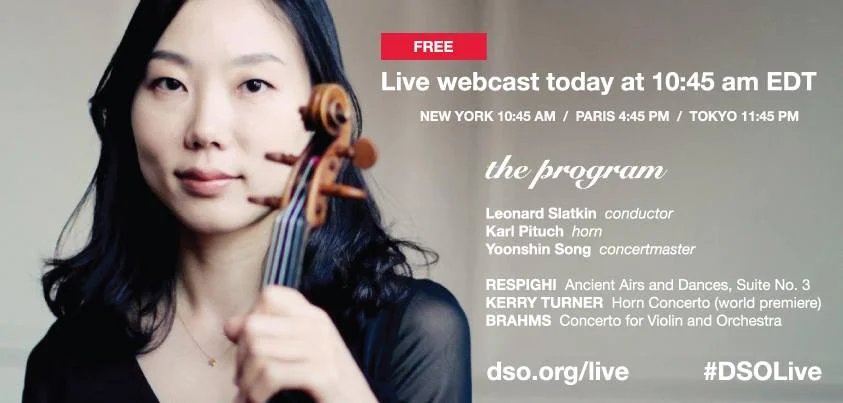Detroit Symphony Orchestra
Last month, I introduced the Berlin Philharmonics’ Digital Concert Hall as a best-practice example of creating online audiences by a symphony orchestra. Indeed, we can find orchestras worldwide reaching out for audiences beyond the walls of a traditional concert hall. So let us inspect three of these orchestras—the Detroit Symphony Orchestra, the Sydney Symphony Orchestra, and the Philharmonia Orchestra (UK)—and have a closer look at some of the tools they use, how these tools are being implemented, and the resulting opportunities they create.
Live and On-Demand Streaming
The Detroit Symphony Orchestra was the first American orchestra to implement a free live streaming webcast series that enables internet users to watch performances in real-time from the comfort of their homes. Launched on May 5, 2011, the DSO’s “Live from Orchestra Hall” has to date reached more than 120,000 viewers in 75 countries. Its live concerts are available through the DSO Live from Orchestra Hall website, as well as from on-demand classical music platforms such as Paraclassics and Classical TV.
Sydney Symphony Orchestra, www.sydneysymphony.com
The Sydney Symphony Orchestra provides both live concert streaming and concert recordings on demand. Thanks to its collaboration with the Australian Internet service provider Telstra BigPond, concerts can be viewed throughout the season for free at www.bigpondmusic.com/sydneysymphony, via the Sydney Symphony Orchestra’s free mobile app, and on the BigPond Live channel on the Telstra T-Box. In addition, the Sydney Symphony Orchestra podcasts a pre-concert speakers series for selected performances, available on the orchestra’s website.
Through its online series “Featured Films,” the Philharmonia Orchestra (UK) offers a wide range of high-quality video content that is available on-demand, including videos that discuss the orchestra’s repertoire and current projects, listening and instrument guides, as well as interviews with players and principal conductor Esa-Pekka Salonen. Content is distributed through the Philharmonia’s webpage as well as on the video-sharing websites Vimeo and YouTube. Selected featured films are also available for free in a monthly podcast series on iTunes.
Mobile Apps
The Detroit Symphony Orchestra has its own app, “DSO to Go,” a free mobile app for iOS and Android devices. The app allows users to watch live performances, buy concert tickets, preview and purchase digital albums, learn more about the orchestra staff, and receive updates on the latest orchestra news. Similar features are also provided by the Sydney Symphony Orchestra’s Mobile App.
In 2012, the Philharmonia Orchestra, in collaboration with Touch Press, launched the iPad app “The Orchestra,” which allows users to interactively explore orchestral music and instruments and gain insights into the inner workings of the Philharmonia Orchestra. Unlike the apps discussed above, however, “The Orchestra” app costs $9.99 to download (rather than being free).
Implications
As these tools and their implementation show, targeting online audiences is gaining momentum among orchestras worldwide. But to what extent do orchestras actually benefit from creating online audiences? Possibilities include:
- Audience Engagement: Creating online audiences helps to engage an orchestra’s existing audience by enhancing its relationship with loyal customers. At the same time, online technologies allow an orchestra to reach a new, potentially younger and more diverse audience. Insights into the inner workings of an orchestra and the presentation of its musicians shed light on the orchestral industry, while also facilitating interactions between the orchestra and its audience.
- Accessibility: Creating an online audience makes an orchestra more accessible to people that otherwise are not able to attend performances due to time, location, physical, and financial obstacles.
- Arts Education: Online tools allow users to explore and learn about classical music, how it is produced, and by whom. Thus products and services for online audiences contribute to multi-dimensional, enriched concert experiences.
- Marketing: Creating online audiences positions an orchestra in the marketplace as an innovative cultural institution and widens its public recognition, benefitting both the organization and the individual artists it employs.
- Finance: Last, creating online audiences can also introduce new revenue streams. For example, submission fees charged for on-demand videos, apps, and podcasts generate additional earned revenue.
Despite all these positive aspects, creating online audiences also presents a variety of challenges for symphony orchestras. To learn more about challenges and risks associated with the creation of online audiences, stay tuned for my next research update!




